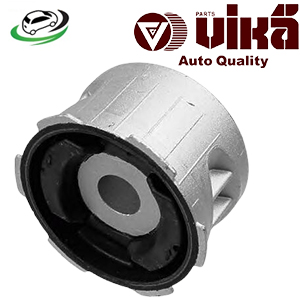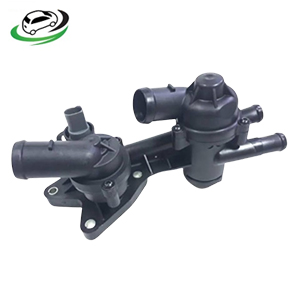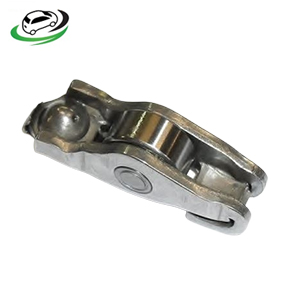-19%
Get Engine Rocker Arm AUDI A3/Sportback / VW CC B7/EOS/Golf Plus V/Golf V/Golf VI/Jetta III/Jetta IV/Passat B6 036109411J
The rocker arm is a crucial component in the internal combustion engine’s valve train. It translates the camshaft’s rotational motion into the linear motion needed to open and close the engine’s intake and exhaust valves. Understanding the function, types, benefits, common issues, and maintenance of rocker arms is essential for appreciating their role in engine performance and efficiency.
Structure and Function of Rocker Arms
Rocker arms are typically made from materials like stamped steel, aluminum, or cast iron, and they play a vital role in the valve operation mechanism.
Components of a Rocker Arm
- Pivot Point: The central fulcrum around which the rocker arm pivots.
- Valve End: The end that contacts the valve stem to open and close the valve.
- Pushrod End: The end that contacts the pushrod (in pushrod engines) or the camshaft lobe (in overhead cam engines).
- Oil Passage: Some rocker arms have an internal passage for oil, which aids in lubrication.
Function in the Valve Train
The primary function of the rocker arm is to act as a lever that translates the camshaft’s motion into valve movement:
- Camshaft Rotation: As the camshaft rotates, its lobes push against the pushrod (in pushrod engines) or directly against the rocker arm (in overhead cam engines).
- Rocker Arm Movement: The pushrod pushes one end of the rocker arm upwards, causing the other end to push downwards on the valve stem.
- Valve Operation: This movement opens the valve, allowing the intake of air-fuel mixture or the exhaust of combustion gases. When the camshaft lobe rotates away, the valve spring returns the valve to its closed position.
Types of Rocker Arms
Rocker arms come in various types, each suited to different engine designs and performance requirements.
Stamped Steel Rocker Arms
Stamped steel rocker arms are common in many production engines. They are affordable to produce and provide reliable performance for standard driving conditions.
Roller Rocker Arms
Roller rocker arms feature a roller bearing at the valve end, which reduces friction and wear. These are commonly used in high-performance engines due to their ability to handle higher rpm and loads.
Shaft-Mounted Rocker Arms
In some high-performance and racing applications, rocker arms are mounted on a shaft rather than a stud. This design provides greater stability and can handle higher loads, improving valve train durability and performance.
Aluminum Rocker Arms
Aluminum rocker arms are lightweight and help reduce the overall mass of the valve train. They are used in high-performance applications where weight savings and strength are critical.
Benefits of Rocker Arms
Rocker arms offer numerous benefits that enhance engine performance, efficiency, and durability.
Improved Valve Operation
Rocker arms ensure precise opening and closing of the engine’s valves, which is critical for optimal combustion and engine performance. Accurate valve timing improves power output, fuel efficiency, and emissions control.
Reduced Friction
High-quality rocker arms, especially roller types, reduce friction between the camshaft and the valve train. This reduction in friction leads to lower wear and tear, improved efficiency, and increased engine longevity.
Enhanced Performance
Performance-oriented rocker arms, such as roller and aluminum types, can handle higher engine speeds and loads. This capability allows for more aggressive camshaft profiles and higher rpm limits, translating into better engine performance.
Durability and Reliability
Modern rocker arms are designed for durability, using advanced materials and manufacturing techniques to withstand the stresses of high-performance engines. This durability ensures reliable valve operation over the engine’s lifespan.
Common Issues and Maintenance of Rocker Arms
Like all mechanical components, rocker arms can experience wear and tear over time. Regular inspection and maintenance are crucial for ensuring their proper function.
Signs of Worn Rocker Arms
- Noise: Ticking or clattering noises from the valve train area can indicate worn or loose rocker arms.
- Poor Performance: Reduced engine performance, rough idling, or misfires can be signs of rocker arm issues.
- Excessive Wear: Visible wear on the camshaft lobes, pushrods, or valve stems can indicate rocker arm problems.
- Oil Leaks: Oil leaks from the valve cover area may suggest issues with the rocker arms or related components.
Maintenance Tips
- Regular Inspection: Periodically inspect the rocker arms for signs of wear, damage, or looseness.
- Proper Lubrication: Ensure adequate lubrication of the valve train components to reduce friction and wear.
- Valve Lash Adjustment: Regularly adjust the valve lash (clearance) to maintain proper valve operation, especially in engines without hydraulic lifters.
- Timely Replacement: Replace worn or damaged rocker arms promptly to avoid further engine damage and maintain performance.
Advances in Rocker Arm Technology
Modern advancements in rocker arm technology have led to improved performance, durability, and efficiency.
Advanced Materials
The use of advanced materials, such as high-strength steel alloys and lightweight aluminum, enhances the strength and durability of rocker arms. These materials are designed to withstand the high stresses and temperatures of modern engines.
Precision Engineering
Improved manufacturing techniques, such as CNC machining and precision casting, ensure that rocker arms meet high standards of quality and consistency. This precision results in better performance and reliability.
Roller and Needle Bearings
The incorporation of roller and needle bearings in rocker arms reduces friction and wear, allowing for smoother and more efficient valve operation. These bearings are especially beneficial in high-performance and high-rpm engines.
Variable Valve Timing Integration
In modern engines with variable valve timing (VVT) systems, rocker arms are designed to work seamlessly with VVT mechanisms. This integration improves overall engine efficiency and performance by allowing for dynamic adjustment of valve timing.
Follow us on Facebook for more parts.



